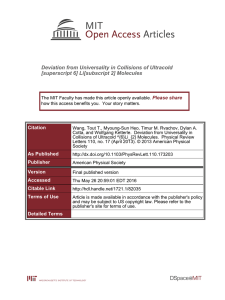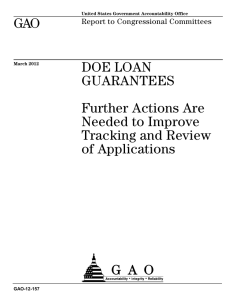SOME SUMS OF LEGENDRE AND JACOBI POLYNOMIALS (
advertisement
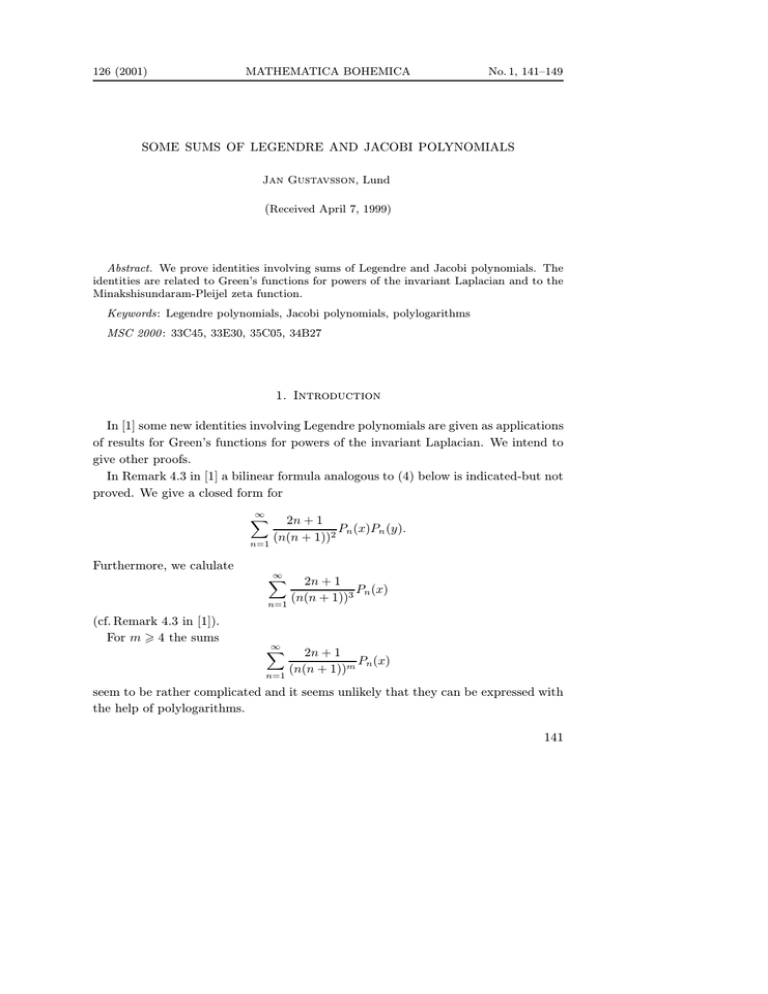
126 (2001) MATHEMATICA BOHEMICA No. 1, 141–149 SOME SUMS OF LEGENDRE AND JACOBI POLYNOMIALS Jan Gustavsson, Lund (Received April 7, 1999) Abstract. We prove identities involving sums of Legendre and Jacobi polynomials. The identities are related to Green’s functions for powers of the invariant Laplacian and to the Minakshisundaram-Pleijel zeta function. Keywords: Legendre polynomials, Jacobi polynomials, polylogarithms MSC 2000 : 33C45, 33E30, 35C05, 34B27 1. Introduction In [1] some new identities involving Legendre polynomials are given as applications of results for Green’s functions for powers of the invariant Laplacian. We intend to give other proofs. In Remark 4.3 in [1] a bilinear formula analogous to (4) below is indicated-but not proved. We give a closed form for ∞ 2n + 1 Pn (x)Pn (y). (n(n + 1))2 n=1 Furthermore, we calulate ∞ 2n + 1 Pn (x) (n(n + 1))3 n=1 (cf. Remark 4.3 in [1]). For m 4 the sums ∞ 2n + 1 Pn (x) (n(n + 1))m n=1 seem to be rather complicated and it seems unlikely that they can be expressed with the help of polylogarithms. 141 2. Prelimaries The sums in [1] for which we will give alternative proofs are (1) ∞ 2n + 1 Pn (x) = log 2 − 1 − log(1 − x), n(n + 1) n=1 (2) ∞ ν+1 1 1−x 2n + ν + 1 (0,ν) Pn (x) = − − log , n(n + ν + 1) j 2 n=1 j=1 ∞ (3) 2n + 1 Pn (x) (n(n + 1))2 n=1 = log (4) 1 − x 2 1 2 1−x · log − log2 + Li2 − + 1, 1+x 1+x 2 1+x 1+x ∞ 2n + 1 Pn (x)Pn (y) n(n + 1) n=1 = 2 log 2 − 1 − log(1 − x)(1 + y) if − 1 < x y < 1. For some simplifications we will need Landau’s functional equation (5) Li2 (z) + Li2 − 1 z = − log2 (1 − z) 1−z 2 and an equation by Euler (6) Li2 (z) + Li2 (1 − z) = see [2]. If we use (5) and (6) with z = log 1−x 2 2 − log z · log(1 − z), 6 we get 2 1 2 1−x 1−x · log − log2 + Li2 (− )+1 1+x 1+x 2 1+x 1+x 1−x 1 + x 2 1 2 1−x = log − log · log − log2 − Li2 2 2 1+x 2 1+x 2 1 − x 2 1 1 + x 1 − x 2 1+x + 1 = log · log − Li2 +1=1− + Li2 . − log2 2 2 2 1+x 2 6 2 Thus we have simplified the right hand side of (3). 142 From [3] we have some basic facts for Jacobi polynomials. The defining equation is (α,β) dPn(α,β) (x) d (x) dPn (1−x2 ) + β −α−(λ−1)x +n(n+λ)Pn(α,β)(x) = 0 dx dx dx (7) where λ = α + β + 1. Suppose formally that f (x) = ∞ cn Pn(α,β) (x). n=0 Then cn = (8) 1 hn 1 −1 f (x)Pn(α,β) (x)(1 − x)α (1 + x)β dx where hn = (9) 2λ Γ(n + α + 1)Γ(n + β + 1) . (2n + λ)n!Γ(n + λ) We will also need Pn(α,β) (1) = (10) (α + 1)(α + 2) · . . . · (α + n) . n! 3. Some sums of (1) and (2). Combining (7) and (8) yields −n(n + λ)cn hn = (11) + 1 −1 (α,β) d (x) dPn (1 − x2 ) f (x)(1 − x)α (1 + x)β dx dx dx dPn(α,β) (x) f (x)(1 − x)α (1 + x)β dx. β − α − (λ − 1)x dx −1 1 Integration by parts transforms the first integral to (α,β) 1 (x) dPn (1 − x2 ) f (x)(1 − x)α (1 + x)β dx −1 1 (α,β) dPn (x) f (x)(1 − x)α+1 (1 + x)β+1 dx − dx −1 1 (α,β) dPn (x) f (x)(β − α − (λ − 1)x)(1 − x)α (1 + x)β dx. − dx −1 143 Combining the two integrals in (11) yields −n(n + λ)cn hn = − 1 (α,β) dPn −1 (x) dx f (x)(1 − x)α+1 (1 + x)β+1 dx 1 = − Pn(α,β) (x)f (x)(1 − x)α+1 (1 + x)β+1 −1 1 d f (x)(1 − x)α+1 (1 + x)β+1 dx. + Pn(α,β) (x) dx −1 (12) To prove (1) we specify f (x) = log 2 − 1 − log(1 − x) = −1 − log Then 1−x , 2 and α = β = 0. d f (x)(1 − x)α+1 (1 + x)β+1 = 1 dx and the second integral in (12) vanishes for n 1. Since (α,β) 1 Pn (x)f (x)(1 − x)α+1 (1 + x)β+1 −1 = Pn (1) · 2 = 2 and hn = we have cn = 2 2n + 1 2n + 1 , n(n + 1) n1 (see (9) and (10)). It remains to determine c0 . However, 1 f (x) dx = 0. −1 Thus c0 = 0 and we have proved (1). In order to prove (2) we start with a redefinition of f (x) = − ν+1 j=1 1−x 1 − log . j 2 Furthermore, put α = 0 and β = ν. Then—see (12)— d d f (x)(1 − x)α+1 (1 + x)β+1 = f (x)(1 − x)(1 + x)ν+1 = (ν + 1)(1 + x)ν dx dx 144 and the second integral in (12) vanishes for n 1. Since Pn(α,β) (x)f (x)(1 − x)α+1 (1 + x)β+1 and hn = we have cn = 1 −1 = Pn(0,ν) (1) · 2ν+1 = 2ν+1 2ν+1 2n + ν + 1 2n + ν + 1 , n(n + ν + 1) n 1. To complete the proof of (2) we evaluate 1 (13) −1 ν+1 2ν+1 1 − ν + 1 j=1 j f (x)(1 + x)ν dx = − 1 log −1 1−x (1 + x)ν dx. 2 In the last integral in (13) we make the substitution x = 1 log −1 1−t 1+t . Then ∞ 2ν+1 t · log dt 1 + t (1 + t)ν+2 0 ∞ ∞ log t log(1 + t) = 2ν+1 dt − dt ν+2 (1 + t) (1 + t)ν+2 0 0 ν ν+1 1 1 2ν+1 1 1 = − − = 2ν+1 − ν + 1 j=1 j (ν + 1)2 ν + 1 j=1 j 1−x (1 + x)ν dx = 2 (14) where we have used the fact that ν 1 log t 1 − + + log t − log(1 + t) ν +1 (1 + t)ν+1 j=1 j(1 + t)j is a primitive function to log t (1+t)ν+2 . Combining (13) and (14) we get c0 h 0 = 1 f (x)(1 + x)ν dx = 0. −1 We have proved (2). 1. The technique is also applicable to sums involving other Jacobi polynomials, e.g. ∞ 1−x 1 (2n + 3)(n + 2) (1,1) 7 1 Pn (x) = − − log + . 6n(n + 3) 9 3 2 3(1 − x) n=1 145 of (3). To simplify the notation we define—or redefine—some functions: 1−x , 2 1−x F (x) = (1 − x) log , 2 F (x) , g(x) = 2 x −1 2 1+x G(x) = 1 − + Li2 . 6 2 f (x) = −1 − log Then F (x) = f (x) and G (x) = g(x). According to (1) we have 2n + 1 hn = n(n + 1) 1 1 f (x)Pn (x) dx = F (x)Pn (x) −1 − −1 1 −1 F (x)Pn (x) dx =0 1 1 1 g(x)(x2 − 1)Pn (x) dx = − G(x)(x2 − 1) Pn (x) −1 −1 =− →0 as x→±1 d ((x2 − 1)Pn (x)) dx = n(n + 1) + G(x) dx −1 1 −1 G(x)Pn (x) dx. n(n+1)Pn (x) We have proved that 1 hn 1 −1 G(x)Pn (x) dx = 2n + 1 (n(n + 1))2 if n = 1, 2, . . . After integration by parts we can complete the proof with 1 G(x) dx = 0. −1 of (3). We intend to prove that ∞ (2n + 1) Pn (x) (n(n + 1))3 n=1 (15) = 1−x 2 1−x 1+x 1−x − 2 + 2ζ(3) + log · Li2 − Li2 − 2 Li3 . 6 2 2 2 2 We use the same technique as above. 146 Redefine f (x) = 1 − 2 1+x + Li2 , 6 2 1−x 2 1+x (1 + x) + (1 + x) Li2 − (1 − x) log , 6 2 2 F (x) , g(x) = 2 x −1 1−x 2 1−x 1+x 1−x G(x) = − 2 + 2ζ(3) + log · Li2 − Li2 − 2 Li3 . 6 2 2 2 2 F (x) = − Then F (x) = f (x) and G (x) = g(x). According to (3) we have 2n + 1 hn = (n(n + 1))2 1 1 f (x)Pn (x) dx = F (x)Pn (x) −1 − −1 1 −1 F (x)Pn (x) dx =0 1 1 1 g(x)(x2 − 1)Pn (x) dx = − G(x)(x2 − 1) Pn (x) −1 −1 =− →0 as x→±1 d ((x2 − 1)Pn (x)) dx = n(n + 1) + G(x) dx −1 1 −1 G(x)Pn (x) dx. n(n+1)Pn (x) Since 1 −1 G(x) dx = [(x − 1)G(x)]1−1 − 1 −1 F (x) dx x+1 1 − x 2 1+x 1−x − + Li2 − log dx 6 2 1+x 2 −1 2 2 2 2 = −4+ − −2 + − +2 =0 3 3 3 3 2 −4− = 3 1 we get c0 = 0. We have proved (15). of (4). Now we redefine f as f (x) = −1 − log −1 − log 1−x 1+y 2 2 if −1xy 2 2 if y x 1. 1+x 1−y If f (x) = ∞ cn Pn (x) n=0 147 then c0 = 1 2 1 −1 f (x) dx = 0 and for n 1 1 − x 1 + y 1 + log Pn (x) dx 2 2 −1 1 1 + x 1 − y 1 + log Pn (x) dx − 2 2 y y 1 − x 1 + y d 1 1 + log ((x2 − 1)Pn (x)) dx = − n(n + 1) −1 2 2 dx 1 1 + x 1 − y d 1 1 + log ((x2 − 1)Pn (x)) dx. − n(n + 1) y 2 2 dx h n cn = − y Thus integration by parts yields 1 − x 1 + y y (x2 − 1)Pn (x) 2 2 −1 y 1 + x 1 − y 1 (x2 − 1)Pn (x) + (x + 1)Pn (x) dx − 1 + log 2 2 y −1 1 + (x − 1)Pn (x) dx = [(x + 1)Pn (x)]y−1 + [(x − 1)Pn (x)]1y n(n + 1)hn cn = − 1 + log y − 1 −1 Pn (x) dx = 2Pn (y). We have proved that cn = (2n + 1)Pn (y) , n(n + 1) which completes the proof of (4). of (4). We intend to prove that ∞ 2n + 1 Pn (x)Pn (y) (n(n + 1))2 n=1 1−x 1−y 1 − log 1+y + Li2 2 · log 2 2 = 1−x 1−y 1+x 1 − log 2 · log 2 2 + Li2 1+x 2 1+y 2 1+y 2 Li2 1+x 2 − Li2 if −1<xy <1 − if − 1 < y x < 1. A formula like this is wanted in Remark 4.3 in [1]. In this proof we will recognize the pattern of the above proofs. However, first we need the notation f (x) = 148 −1 − log −1 − log 1−x 1+y 2 2 if −1xy 2 2 if y x 1, 1+x 1−y F (x) = 1+y F1 (x) = (1 − x) log 1−x 2 − (x + 1) log 2 1+x 2 F2 (x) = −(1 + x) log F1 (x) x2 −1 F2 (x) x2 −1 g(x) = G(x) = 1 − log 1+y 2 · log 1 − log 1+x 2 · − (x − 1) log if −1xy if y x 1, 1−x 1−y + Li2 1+x 2 2 2 1−x 1−y 1+y log 2 2 + Li2 2 −1xy if 1−y 2 1+y 2 1+x Li2 2 if y x 1, − Li2 if −1xy − if y x 1. Then the functions f, F, g and G are continuous at x = y and furthermore F = f and G = g. Again integration by parts is useful. We get 1 G(x) dx = 0. −1 Finally, (4) yields 2n + 1 Pn (y)hn = n(n + 1) 1 −1 1 F (x)Pn (x) −1 f (x)Pn (x) dx = =0 because F1 (−1)=F2 (1)=0 1 1 1 g(x)(x2 − 1)Pn (x) dx = − G(x)(x2 − 1) Pn (x) −1 −1 − →0 as x→±1 G(x) + −1 d ((x2 − 1)Pn (x)) dx. dx n(n+1)Pn (x) We complete the proof with 1 hn 1 −1 G(x)Pn (x) dx = 2n + 1 Pn (y). (n(n + 1))2 References [1] M. Engliš, J. Peetre: Green’s functions for powers of the invariant Laplacian. Canad J. Math. 50 (1998), 40–73. [2] L. Lewin: Structural Properties of Polylogarithms. Math. Surveys Monographs 37, American Mathematical Society, Providence, RI, 1991. [3] Y. L. Luke: The Special Functions and Their Approximation. Volume I. Academic Press, New York, London, 1969. Author’s address: Jan Gustavsson, Centre for Mathematical Sciences, Lund Institute of Technology, Mathematics, Box 118, SE-221 00 Lund, Sweden, e-mail: jang@maths.lth.se. 149

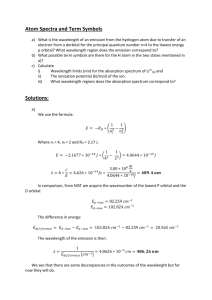
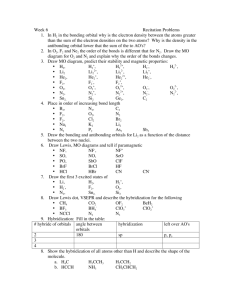


![arXiv:math/0407078v1 [math.QA] 6 Jul 2004](http://s2.studylib.net/store/data/018324890_1-f83bc353123ae33fab66674096cc975f-300x300.png)
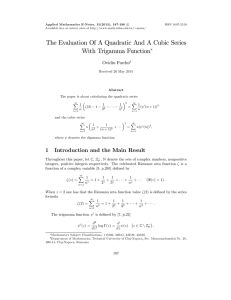

![Rate-Dependent Morphology of Li[subscript 2]O[subscript 2] Growth in Li–O[subscript 2] Batteries](http://s2.studylib.net/store/data/012435713_1-6fd1d4f7d084a3280465672dcafbc14b-300x300.png)
